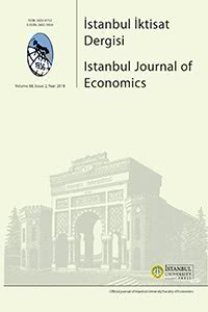A CLOSER LOOK AT THE MONEY MULTIPLIERS FOR THE TURKISH ECONOMY: IS THERE A STABLE RELATIONSHIP?
Bu çalışma Türkiye ekonomisindeki para çarpanı süreçlerinin istikrarlı ve tahmin edilir olup olmadığını incelemektedir. 1987Q1 – 2009Q4 dönemi için üçer aylık veri sıklığını kullanan araştırma bulguları parasal taban arzı büyüklüklerini nihai parasal büyüklüklere çeviren süreçlerin istikrarlı olmadığını ve parasal yetkililer tarafından izlenen politikalarının etkinliğini azaltma eğiliminde olduğunu göstermektedir. Bu tür bir sonuç Türkiye ekonomisinde parasal ekonomi politikalarının yönetiminde geleneksel parasalcı reçetelere güvenilirlik atfetmemektedir
Anahtar Kelimeler:
Para Çarpanları, Türkiye Ekonomisi
A CLOSER LOOK AT THE MONEY MULTIPLIERS FOR THE TURKISH ECONOMY: IS THERE A STABLE RELATIONSHIP?
This paper examines whether the money multiplier processes in the Turkish economy are stable and can be forecasted. Research results using quarterly frequency data for the 1987Q1 – 2009Q4 investigation period show that the processes which convert the base money supply aggregates into the final monetary aggregates are unstable and tend to decrease the effectiveness of policies pursued by the monetary authorities. Such a result do not attribute credibility to the traditional Monetarist prescriptions for the conduct of the monetary economic policies in the Turkish economy
Keywords:
Money Multipliers, Turkish Economy JEL Classification, C32 ; E51,
___
- Baghestani, H. and Mott, T. (1997), “A Cointegration Analysis of the U.S. Money Supply Strategies”, Journal of Macroeconomics, 19/2, 269-283.
- Begg, D., Fischer, S. and Dornbusch, R. (1994), Economics, Fourth Ed., 1994.
- Bornhoff, E.J. (1977), “Predicting the Money Multiplier: A Case Study for the US and the Netherlands”, Journal of Monetary Economics, 3/3, 325-345.
- Brunner, K. and Meltzer, A.H. (1983), “Strategies and Tactics for Monetary Control”, CarnegieRochester Conference Series on Public Policy, 18, 59-103.
- Büttler, H.J., Gargerat, J.-F., Schiltknecht, H. and Schiltknecht, K. (1979), “A Multiplier Model for Controlling the Money Stock”, Journal of Monetary Economics, 5/3, 327-341.
- Dickey, D.A. and Fuller, W.A. (1979), “Distribution of the Estimators for Autoregressive Time Series with A Unit Root”, Journal of American Statistical Association, 74/366, 427431.
- Dickey, D.A., Jansen, D.W. and Thornton, D.L. (1991), “A Primer on Cointegration with an Application to Money and Income”, Federal Reserve Bank of St. Louis Review, March/April, 58-78.
- Douglas, W.M. and Speaker, P.J. (1991), “Non-parametric Tests of the Efficacy of Money Stock Control Strategies”, Economic Modelling, 8/1, 83-89.
- Engle, R.F. and Granger, C.W.J. (1987), “Cointegration and Error Correction: Representation, Estimation and Testing”, Econometrica, 55/2, 251-276.
- Friedman, M. (1968), “The Role of Monetary Policy”, The American Economic Review, 58/1, 1-17.
- Gonzalo, J. (1994), “Five Alternative Methods of Estimating Long - Run Equilibrium Relationships”, Journal of Econometrics, 60, 203-233.
- Gökbudak, N. (1995), “Money Multiplier and Monetary Control”, CBRT Research Department Working Paper , No. 9505, October.
- Hafer, R.W. and Hein, S.E. (1984), “Predicting the Money Multiplier: Forecasts from Component and Aggregate Models”, Journal of Monetary Economics, 14/3, 375-384.
- Johannes, J.M. and Rasche, R.H. (1979), “Predicting the Money Multiplier”, Journal of Monetary Economics, 5/3, 301-325.
- Johansen, S. (1995), Likelihood-based Inference in Cointegrated Vector Autoregressive Models, Oxford: Oxford University Press.
- Johansen, S. and Juselius, K. (1990), “Maximum Likelihood Estimation and Inference on Cointegration-with applications to the demand for money”, Oxford Bulletin of Economics and Statistics, 52, 169-210.
- Keyder, N. (1998), Para, Teori, Politika, Uygulama, Geliştirilmiş 6. Baskı, Ankara: Beta Dağıtım.
- MacKinnon, J.G. (1996), “Numerical Distribution Functions for Unit Root and Cointegration Tests”, Journal of Applied Econometrics, 11, 601-618.
- MacKinnon, J.G., Haug, A.A. and Michelis, L. (1999), “Numerical Distribution Functions of Likelihood Ratio Tests for Cointegration”, Journal of Applied Econometrics, 14, 563577.
- Osterwald-Lenum, M. (1992), “A Note with Quantiles of the Asymptotic Distribution of the Maximum Likelihood Cointegration Rank Test Statistics”, Oxford Bulletin of Economics and Statistics, 54, 461-472.
- Paya, M. (1998), Para Teorisi ve Para Politikası, İstanbul: Filiz Kitabevi.
- Perron, P. (1989), “The Great Crash, the Oil Price Shock, and the Unit Root Hypothesis”, Econometrica, 57, 1361-1401.
- Phillips, P.C.B. and Perron, P. (1988), “Testing for a Unit Root in Time Series Regression”, Biometrika, 75, 335-346.
- Sharpe, I.G. (1980), “Australian Money Supply Analysis: The Relationship between Monetary Base, Secondary Reserves and the Money Supply”, Journal of Banking & Finance, 4/3, 283-300.
- Spindt, P.A. (1983), “The Monetary Multiplier When Money is Measured as a Divisia Quantity Index”, Economics Letters, 13/2-3, 219-222.
- Şahinbeyoğlu, G. (1995), “The Stability of Money Multiplier: A Test for Cointegration”, CBRT Research Department Working Paper, No: 9603, December.
- Zivot, E. and Andrews, D.W.K. (1992), “Further Evidence of Great Crash, the Oil Price Shock and the Unit Root Hypothesis”, Journal of Business and Economic Statistics, 10, 251270.
- ISSN: 2602-4152
- Yayın Aralığı: Yılda 2 Sayı
- Başlangıç: 1939
- Yayıncı: İstanbul Üniversitesi
Sayıdaki Diğer Makaleler
RUSYA'DA SERBEST PİYASA EKONOMİSİNE GEÇİŞ SÜRECİ ve 2008 KÜRESEL KRİZİ
İsmail İŞCAN, Yıldız HATİPOĞLU
OECD VE AB ÜYESİ ÜLKELERDEVERGİ SİSTEMLERİNİN STRATEJİK TASARIMI: KARŞILAŞTIRMALI ÜLKE ANALİZİ
Kemalettin ÇONKAR, Cemal ELİTAŞ, Gökhan ATAR
MAX WEBER'İN İKTİSAT SOSYOLOJİSİ AÇISINDAN YORUMUNDA ORTA ÇAĞIN KATOLİK ASKETİKİZMİNDEN KOPUŞ
“FİNANSAL KABARCIKLAR” TEORİSİ ve FİNANSAL KRİZLER
A CLOSER LOOK AT THE MONEY MULTIPLIERS FOR THE TURKISH ECONOMY: IS THERE A STABLE RELATIONSHIP?
Coasevarî İşlemlerin Refah Etkileri: Genelleştirilmiş Grafiksel Bir Yaklaşım
TÜRKİYE'DE EKONOMİK BÜYÜME VE KAMU HARCAMALARI ARASINDAKİ İLİŞKİNİN AMPİRİK ANALİZİ: 1950 - 2009
